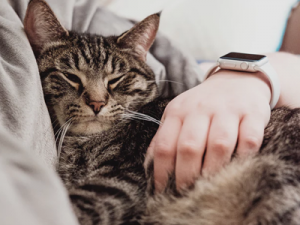As loving pet owners, sometimes we’re a little in denial about our pets growing old, perhaps thinking that your pet’s best years are now behind them and there’s only worries on the horizon (“what if Muffy gets sick?” “What if Buddy doesn’t want to play anymore?”).
The truth is, there’s plenty you can do to help your pet enjoy their senior years as well! And, when you know what to look for, it’s easy to keep your pet comfortable and healthy for many years to come.
As we all know, cats and dogs age at a much different rate to humans, but it may still surprise you to learn at what age your fluffy buddy is considered a senior.
For cats, the title of “senior” is generally given from the age of seven years old, which we find to be rather interesting – we’ve met family cats that have reached their twenties! Dogs on the other hand, are quite different. This is due to difference in life expectancies between breeds, with smaller breeds generally reaching  seniority much later than larger breeds. In general, your dog may be considered a senior anywhere between the ages of five to ten.
seniority much later than larger breeds. In general, your dog may be considered a senior anywhere between the ages of five to ten.
It’s also important to note the difference between a “senior” and a “geriatric” pet. A senior pet may be showing signs of ageing, but all in all they’re still healthy and happy. A geriatric pet however is usually toward the end of the ageing spectrum and is beginning to experience one or more health problems that may be uncomfortable or complicated.
Remember: these signs don’t necessarily mean alarm bells! It just means that they may need a little extra TLC (but we think you’re more than happy to dish that out anyway). Keep in mind that some animals are more likely to let their symptoms show than others. Cats for example are notorious for keeping their discomfort hidden.
Signs that your pet has reached their senior years include…
Change in mobility. As cats and dogs age, it’s very common for them to experience stiff joints or even develop arthritis. This may mean that your pet takes a little longer to get out of bed in the morning, or perhaps very cold weather causes your pet’s joints to appear to stiff. Or, your dog might not want to walk quite as far as they used to. To help with this, you can consider introducing a joint supplement in the form of a powder, chew or treat (Sasha’s Blend, Paw Blackmores and 4Cyte are great), or a specialty food from brands such as Royal Canin and Hill’s Science Diet. These will contain ingredients such as green lipped mussels, glucosamine, chondroitin and omega oils, all of which assist in easing stiff joints. Additionally, make sure they have a nice, comfy bed or spot to sleep with supportive cushioning.
Change in weight. Obesity is common in senior pets, and it’s often tied to the fact that they aren’t moving around as much as they used to (see mobility above). Or, your senior pet could be underweight, suggesting gastrointestinal problems or even dental issues that come with old age. To help with this, you can look for a senior pet diet that contains fewer calories for weight loss, have regular dental check-ups with your vet, and take note of how your pet is reacting to food.
Change in sleeping patterns and alertness. Increased sleep is associated with ageing, as is cognitive behaviour and alertness. A cat or dog may also suddenly become “lost” in their own home, forget familiar faces, or stop responding to vocal queues as they once did. To help with this, check in with your vet to make sure your pet isn’t experiencing the onset of dementia. Pro Plan also make a dog food that focuses on brain health as your dog ages.
Change in drinking and toilet habits. If you’re finding that your cat or dog is drinking more water than usual, it could be an indication of kidney issues. Similarly, urinating a greater volume could signal a health problem such as diabetes or urinary disease – all associated with older pets. Cats can be fussy about their water bowl to begin with, so be sure to be extra vigilant around senior cats. To help with this, keep an eye on your pet’s toileting habits and consult with your vet if you are suspicious about anything. Wet food or a special water fountain may also encourage extra hydration if your pet isn’t drinking enough, which can result in painful urinary stones.
Change in grooming habits. Less grooming may indicate that your pet is feeling a little sore, as many senior pets tend to do. To help with this, regular bathing and gentle brushing sessions are in order – and we think your pet will love this, too!
Not every pet owner realises that shifting their cat or dog from their regular adult food to a senior diet can do wonders for their health (there’s a reason why we have already mentioned your pet’s diet a few times!).
As your pet’s body ages, their nutritional requirements shift quite noticeably. This often begins with changes in their energy needs and metabolism – just like humans’, cats’ and dogs’ metabolisms slow down once they reach their senior years, leading to possible weight gain and muscle wastage. To counteract these changes, a diet higher in protein will not only help to keep your pet fuller for longer, but will also assist in keeping their muscles strong. Additionally, look for a pet food with fewer calories – weight gain and obesity can lead to further health complications, especially in senior pets.
higher in protein will not only help to keep your pet fuller for longer, but will also assist in keeping their muscles strong. Additionally, look for a pet food with fewer calories – weight gain and obesity can lead to further health complications, especially in senior pets.
Advancement in your pet’s age can also lead to a change in their digestive system, making their tummy more sensitive to food that they once enjoyed regularly. This could lead to a disinterest in food all together, which has its own health issues. Many food brands these days offer a “sensitive” diet, particularly those you see at your vet, and these are a great option if you’re finding that your senior pet is having tummy upsets.
Simply put, your pet’s body will be using food in a much different way as they grow older – so a change in their diet is very important. Look into the different options that are out there: you’ll be surprised what there is on offer, and how it can help your pet’s health.
Signs of joint pain and arthritis in senior pets are usually easy to spot and are similar across both cats and dogs. They include changes in movement and behaviour such as:
Arthritis is a degenerative, progressive, and irreversible condition of the joints that unfortunately comes with old age, bringing with it both inflammation and degradation of cartilage. This makes even simple tasks such as walking rather painful for your pets – but thankfully, there are things you can do to help ease their pain.
The first thing we would recommend would be to see your vet to discuss the best options for your pet. Depending on the severity of your pet’s pain, your vet will likely prescribe a pain-relief medication such as Meloxicam. Vets prescribe medication on a case by case basis, as pre-existing health issues may restrict them from use of certain drugs.
At home, you can further support your senior pet’s joints and arthritis with use of supplements (these included ingredients such as omega fatty acids, green lipped mussel and glucosamine) and veterinarian-prescribed diets such as those made by Royal Canin and Hill’s Science Diet. These diets are easier to administer than supplements – no pills required – and come with extensive research and scientific support, ensuring that your pet is getting the best to support their joints in their senior years.
With a little extra knowledge, you’re now well on your way to helping your senior pet be as comfortable as can be. Just don’t forget yearly or half-yearly check-ups with your vet, and you’re set!
Read next: What To Do When A Pet Passes >